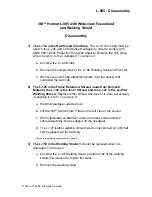
Inspection
1. Remove the plug (A,
Figure 15
) from the drain
hose on the air filter housing. Clean out accumu-
lated moisture or dirt. If necessary, blow the hose
clear with compressed air.
2. Inspect all components of the air filter housing
assembly. Look closely for cracks or other damage
that would allow unfiltered air into the engine. Re-
place any part that is damaged or starting to deterio-
rate.
3. Wipe out the inside of the air filter housing with
a clean rag.
4. If necessary, remove the self-taping screws (B,
Figure 15
) and separate the rear cover (A,
Figure
16
) from the housing (B).
SURGE TANK
Removal
Refer to
Figure 9
.
1. Remove the air filter housing as described in this
chapter.
2. Release the clamp (B,
Figure 14
) and remove
the surge tank duct (A) from the surge tank.
3. Disconnect the cylinder head breather hose (C,
Figure 14
) from the cam sprocket cover on the front
cylinder.
4. Remove the surge tank bolt (D,
Figure 14
) and
collar.
5. Remove the air filter housing bracket bolts (A,
Figure 17
). On California models, note that the
EVAP purge hose (B,
Figure 17
) runs behind the
bracket. Release the fuel hose (C,
Figure 17
) from
the holder on the bracket and lower the air filter
housing bracket from the frame.
6. Loosen the clamp (A,
Figure 18
) that secures
each carburetor duct (B) to the surge tank. Also re-
fer to A,
Figure 19
.
7. Lift the surge tank from the frame, separate each
male fitting on the bottom of the surge tank from its
carburetor duct, and remove the tank. Watch for the
carburetor breather hose (B,
Figure 19
). It may
have to be manually pulled from the recess on the
bottom of the surge tank.
AIR/FUEL, EXHAUST AND EMISSION CONTROL SYSTEMS
209
8
15
16
17
18
















































